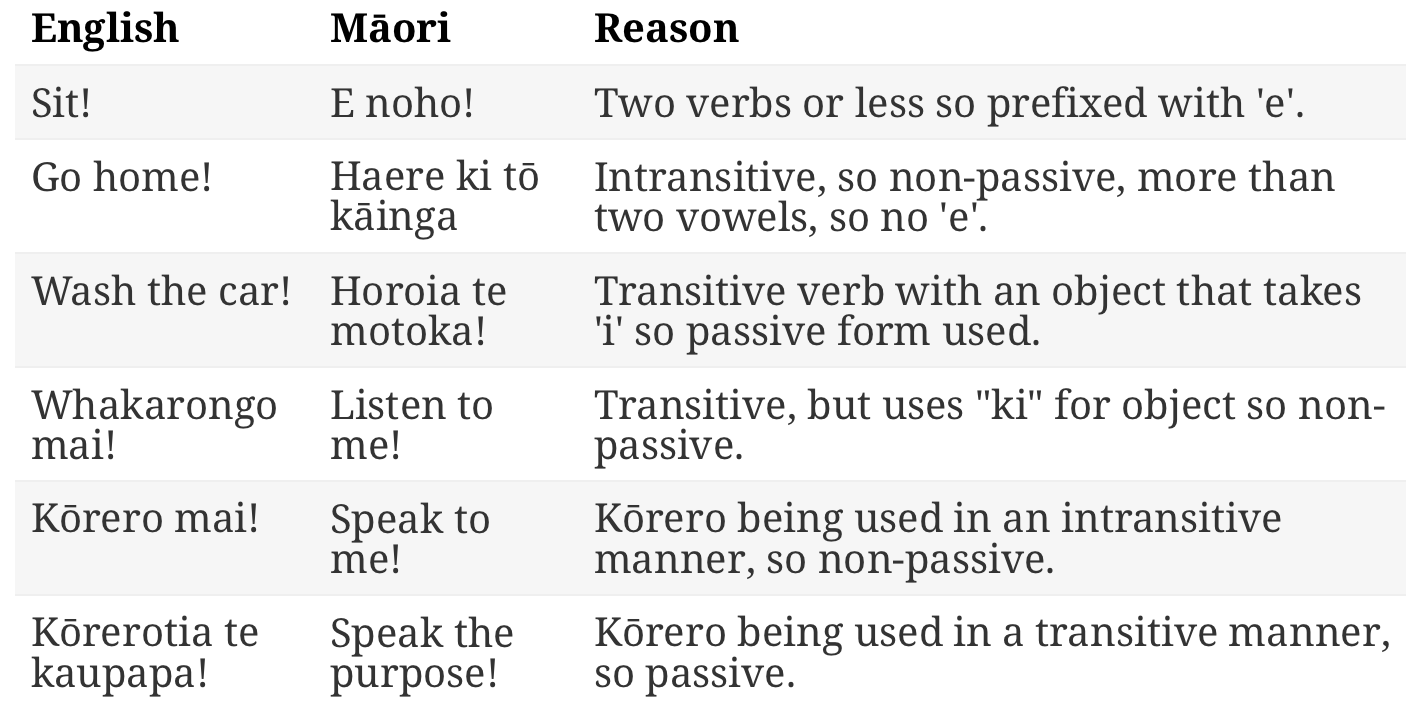When to use 'e' or passives in commands in te reo Māori
I often see questions online about why some commands in te reo Māori have a particle "e" before the command, or why some commands are in a passive form and some are not. This post is my understanding based upon my class notes of why you choose one form over the other.

Commands are used to tell someone to do something. For example, in English we might say "Sit!", "Fetch the ball!" or "Go away!".
I often see questions online about why some commands in te reo Māori have a particle "e" before the command, or why some commands are in a passive form and some are not. This post outlines my understanding of commands in Te Reo Māori and when to choose one form over another. It is based upon my class notes. I welcome feedback to help clarify or correct my understanding.
Verbs with no object
In general the first word of a command sentence is the verb. So for:
"Go Away!"
the command is:
"Haere atu!"
Here, "Haere" is the verb, and "atu" is a direction indicator. If this were re-written to be an action occurring in the present tense, rather than a command, it would be "Kei te haere atu koe", or "You are going away". Sometimes I find it helpful to express what I want the other person to be doing as a sentence, to find the correct verb, then convert that to the command form.
If the verb is short - it has less than three vowels in it - then the verb is preceeded with "e". So for "Run!" the command is "E oma!". "Oma" only has two vowels, hence the "E" at the beginning of the sentence. Another example is "E noho!" or "Sit!".
Directional markers following the verb are added to the vowel count, so while "E piki" is usage for "Climb!", "E piki atu" is generally not for "Climb up!" - it would be "Piki atu!". Note that "rā" is one marker that does not add to the vowel count, hence "E noho rā!" being the term for "Goodbye, to those staying", and "Noho rā!" is not used.
If the command has additional sentence parts, like a location, then these are added in the same way as normal action sentences. So "Go to the marae!" is "Haere atu ki te Marae!" in the same way as you'd describe the action happening with "Kei te haere atu koe ki te Marae".
Verbs with objects
The examples given so far are "intransitive" verbs, or "tūmahi poro". For "transitive" verbs, tūmahi whiti, the form is the same if the object of the sentence is left out. For example, "E kai!", or "eat!" - the object to be eaten is not included. See my article on verb types for a breakdown of verbs into intransitive, transitive, etc.
In the case of verbs where an object is being included, "Eat the apple!", there are two forms that can be used:
- If the verb is one that uses "ki" as the object marker then the verb is used as with intransitive verbs and the object marked with "ki". So "Titiro ki te motoka!" is how you'd express "Look at the car!". This is because "titiro" uses "ki" to mark the object of the sentence - as in the sentence "Kei te titiro koe ki te motoka", "You are looking at the car".
- If the verb uses "i" as the object marker in the sentence then the verb is converted into the passive form and there is no particle marking the object - just like a passive sentence. "Whanaia te pōro!", or "Kick the ball!". Looking at the structure of the passive form of the action version of the sentence helps understand why this structure works - "Kei te whanaia te pōro e koe", "The ball is being kicked by you". Even if there is no object, because it is being implied by pointing or context, if the object would have been marked with an "i" then the passive form is used. For example, "Tuhia!", or "Write!".
There is an exception to the rule about making the verb passive if it uses "i" for an object marker. The exception applies if the object is the person at which the command is directed. In that case, the non-passive form of the verb is used and the particle "i" is used as normal. So "Horoi i a koe!" is "Wash yourself!", not "Horoia koe!".
The following table shows some examples and explanation:
| English | Māori | Reason |
|---|---|---|
| Sit! | E noho! | Two vowels or less so prefixed with 'e'. |
| Go home! | Haere ki tō kāinga | Verb is intransitive, so non-passive, more than two vowels, so no 'e'. |
| Wash the car! | Horoia te motoka! | Transitive verb with an object that takes 'i' so passive form used. |
| Whakarongo mai! | Listen to me! | Transitive, but verb uses "ki" for object so non-passive. |
| Kōrero mai! | Speak to me! | Kōrero being used in an intransitive manner, so non-passive. |
| Kōrerotia te kaupapa! | Speak the purpose! | Kōrero being used in a transitive manner, so passive. |
I used my class notes, Ray Harlow's "A Māori Reference Grammar" and Winifred Bauer's "The Reed Reference Grammar of Māori" as reference material while writing this post.
